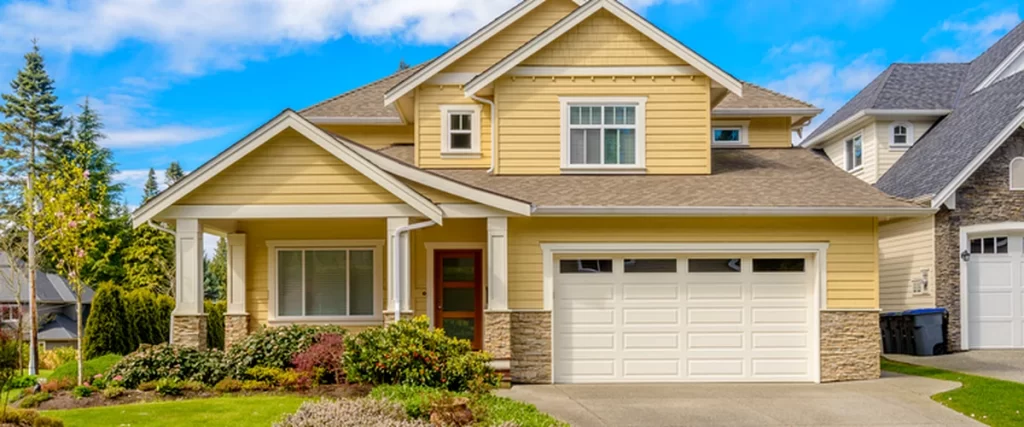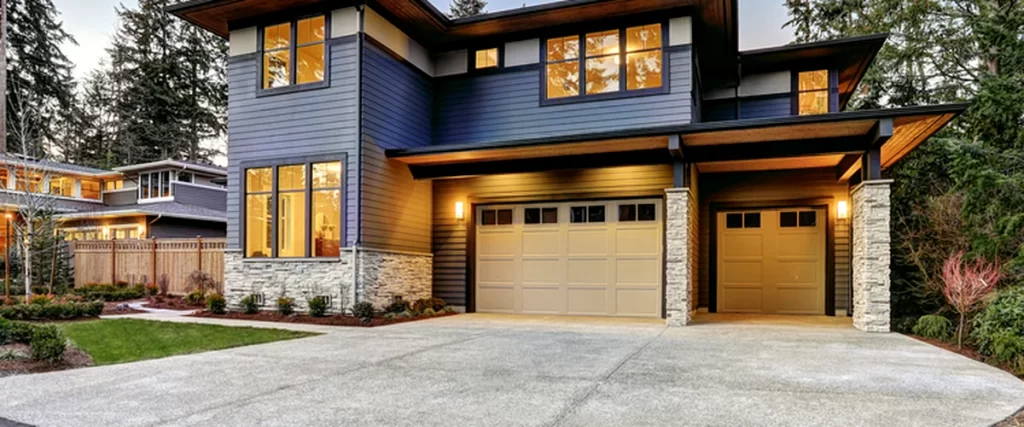Upgrading your home’s exterior brings big rewards: better protection, stronger curb appeal, and less time spent maintaining the surface.
When looking at modern siding materials, polymer siding vs vinyl siding is a common comparison that comes up. Both offer attractive, durable finishes that handle the Midwest’s changing weather, but there are clear differences in how each performs and what kind of look they deliver.
Below, you’ll find a clear breakdown of how polymer and vinyl siding compare in material makeup, appearance, maintenance, durability, energy efficiency, and cost.

Understanding the Basics
Vinyl Siding
Vinyl siding has been one of the most widely used siding materials for decades. It’s made from polyvinyl chloride (PVC), a type of plastic that is molded into panels and often textured to look like wood. Its popularity comes from affordability, ease of installation, and a long lifespan with limited upkeep.
Vinyl siding panels are usually thinner than polymer options, and their flexibility makes them simple to install over large wall sections. This material suits homeowners who want a cost-effective, low-maintenance siding option that looks clean and consistent.
Polymer Siding
Polymer siding is made from polypropylene resin, a plastic polymer that allows for more shape and design flexibility than vinyl. It’s often used for premium siding products that mimic the look of natural materials like cedar shake, hand-split shingles, or even stone textures.
The production process gives polymer siding deeper grooves, more defined grain patterns, and stronger impact resistance. It’s thicker and more rigid, which helps it stay stable under pressure from wind or hail.
How They’re Made
The manufacturing process is one of the main reasons polymer siding and vinyl siding perform differently.
- Vinyl siding: Created through an extrusion process where heated PVC resin is shaped into panels, then coated for UV protection and color retention.
- Polymer siding: Uses injection molding with polypropylene resin, allowing for more intricate patterns and variable thicknesses. This gives polymer siding its characteristic three-dimensional appearance and durability.
These differences also affect color depth. Polymer siding often carries color throughout the material, so scratches or chips are less visible. Vinyl siding is surface-colored, which means deeper damage might show through.
Appearance and Style Options
Modern homeowners have a wide range of style preferences. Both siding types offer strong visual flexibility.
- Vinyl siding: Typically comes in horizontal panels, vertical panels, and lap siding. It’s available in a broad color range and can include subtle wood-grain embossing.
- Polymer siding: Provides more texture and design realism, including shake-style, scalloped edges, or deep cedar impressions. Because of its molding process, it can replicate natural wood with more accuracy.
Homeowners who want to emphasize architectural details often choose polymer siding for accents on gables, dormers, or around entryways, while vinyl siding covers the main body of the home for cost balance.

Durability and Weather Resistance
Both materials are built to handle extreme weather conditions, but they do so in slightly different ways.
- Vinyl siding: Performs well under heat and cold but can become brittle in extreme temperatures. Modern PVC formulations have improved flexibility, helping reduce cracking and warping.
- Polymer siding: Highly resistant to impact, moisture, and temperature swings. Its thicker composition helps it hold shape during storms and resist denting from hail or debris.
Neither material absorbs moisture, which means they are both decay-proof and resistant to pests or rot. This makes them strong contenders for long-term use in areas that experience snow, humidity, and high winds.
Energy Efficiency and Insulation
When considering energy efficiency, the siding itself provides some insulation value, but much of the benefit depends on what lies underneath. Both vinyl and polymer siding can be paired with foam backing or insulated panels to reduce energy loss.
Polymer siding’s thickness offers a slight advantage for home insulation. It helps stabilize indoor temperatures, reducing the strain on heating and cooling systems. A home with properly installed siding can use less energy and maintain comfort more consistently across seasons.
Maintenance Requirements
Both vinyl and polymer siding are known for low maintenance requirements. They never need painting, staining, or sealing. Routine cleaning with mild soap and water is enough to remove dirt, mildew, or dust.
However, polymer siding tends to resist color fading more effectively because its pigment runs through the material, while vinyl siding may fade slightly faster depending on sun exposure and the quality of the panel.
For both, maintenance steps are simple:
- Wash annually or as needed.
- Check for loose panels after storms.
- Trim nearby shrubs or trees to prevent scuffing.
Compared with wood siding or fiber cement siding, both polymer and vinyl are more manageable and require less maintenance over time.
Environmental Impact
When it comes to being eco-friendly, both siding options have improved. Manufacturers in the siding industry now recycle offcuts and use cleaner production processes.
- Vinyl siding, made from polyvinyl chloride, can sometimes be recycled depending on local facilities.
- Polymer siding, made from polypropylene resin, is considered slightly more environmentally friendly because it doesn’t contain chlorine compounds and often has a longer service life.
Choosing a reputable company for your siding installation ensures proper disposal of waste materials and minimal environmental impact.
Cost Effectiveness
Cost plays a large role in any home improvement project.
- Vinyl siding remains the lower-cost option. It provides broad color and texture selections without straining the budget.
- Polymer siding is typically more expensive per square foot because of its material density and manufacturing complexity. However, its durability and enhanced appearance can offer better cost-effectiveness over decades of use.
Homeowners often blend the two materials: using polymer siding for accent areas and vinyl siding for the main walls, to strike a balance between performance and price.
Longevity and Warranty
Both siding materials can last 25 to 40 years, depending on the quality of installation and exposure to the elements. Polymer siding’s thicker panels and impact resistance can extend lifespan further, especially in regions with harsh weather conditions.
A professional siding installation is vital for preventing water infiltration, buckling, or poor alignment. A reputable company provides workmanship warranties along with manufacturer coverage, giving homeowners long-term confidence in the investment.
Comparing Polymer Siding vs Vinyl Siding
| Feature | Polymer Siding | Vinyl Siding |
| Material Composition | Made from polypropylene resin | Made from polyvinyl chloride (PVC) |
| Durability | Thicker, highly resistant to impact | Flexible, durable under normal conditions |
| Appearance | More texture and depth, natural wood look | Smooth or wood-grain options, traditional panels |
| Maintenance | Low maintenance, strong color retention | Low maintenance, may fade slightly faster |
| Energy Efficiency | Better insulation due to thickness | Moderate, can improve with insulated backing |
| Environmental Impact | Recyclable, chlorine-free resin | Recyclable but contains PVC compounds |
| Cost | Higher initial cost, long-term value | Lower cost, widely available |
| Lifespan | 30–50 years | 25–40 years |
Choosing the Right Material
Every home and homeowner has different needs. The main difference between polymer siding and vinyl siding lies in durability and design. Polymer provides higher impact resistance and stronger texture detail, while vinyl delivers reliable performance at a lower price point.
When comparing vinyl and polymer siding, consider:
- The home’s architectural style and texture preferences.
- Exposure to wind, hail, or direct sunlight.
- Long-term maintenance comfort level.
- Budget and timeline for installation.
The construction industry continues to innovate, and both materials have become better over time. With improved UV protection, color consistency, and installation methods, today’s siding options are far more advanced than those produced even a decade ago.

Final Thoughts
Choosing the right siding material can significantly impact your home’s comfort, efficiency, and appearance for years. Vinyl and polymer siding both offer numerous benefits, from weather resistance to low upkeep, but making an informed decision depends on your goals for cost, design, and performance.
If comparing these materials feels overwhelming, our team at Carp’s Complete Exteriors is ready to help. We’ve worked with both vinyl and polymer siding across many homes in the region and can guide you toward the right material for your exterior.
Save time researching and make the most of your next siding installation project. For advice, product options, or a free estimate, call us at (402) 651-1493 or message us here to connect with a siding specialist who knows what works best for our local weather and your home.
